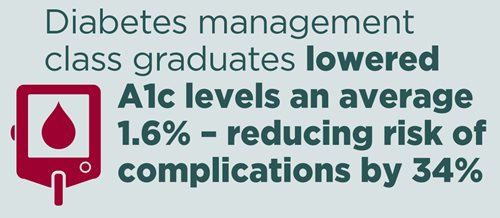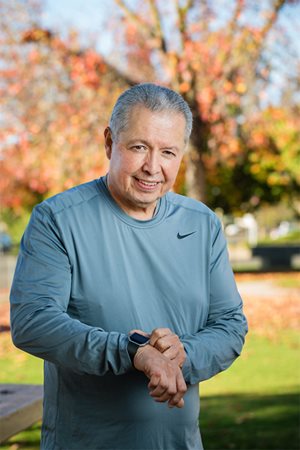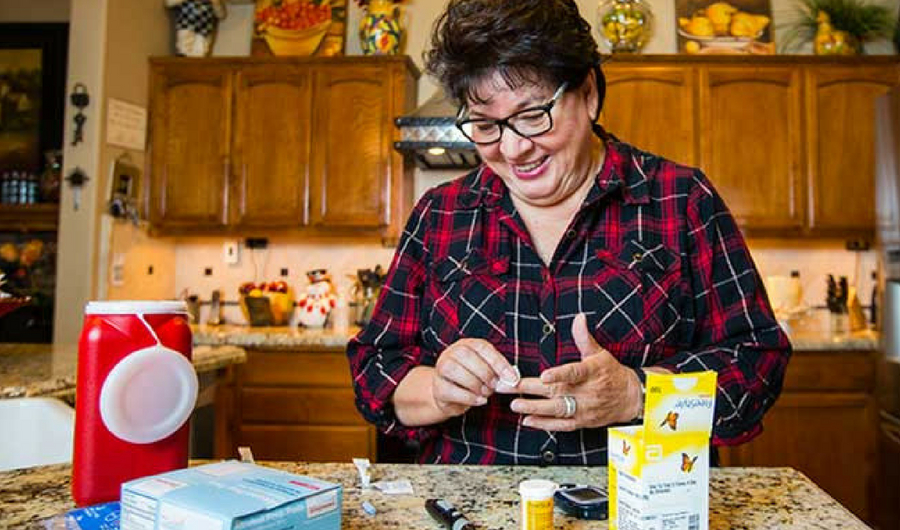Don’t wait for a heart attack to act
 The longtime nurse had blood sugar levels seven times as high as normal when she reached the emergency room at Clovis Community Medical Center and her A1c was two-and-a-half times what it should’ve been. She had 100% blockage of one of her critical arteries to the heart. Heart disease is one of the complications of uncontrolled diabetes, along with the risk of kidney failure, amputations and blindness.
The longtime nurse had blood sugar levels seven times as high as normal when she reached the emergency room at Clovis Community Medical Center and her A1c was two-and-a-half times what it should’ve been. She had 100% blockage of one of her critical arteries to the heart. Heart disease is one of the complications of uncontrolled diabetes, along with the risk of kidney failure, amputations and blindness.As soon as she recovered from her heart attack, Christensen, a 65-year-old Clovis grandma of five boys, got serious about her diabetes. “I had an angel looking after me that night,” she said. “I learned a very good lesson. Don’t ignore your health.”
Get help controlling diabetes with ADA-certified classes
Her results are typical for the patients who complete the eight hours of diabetes management classes at Community. Nearly 1,500 enroll annually in the area’s only American Diabetes Association (ADA) certified management classes. More than half those attending class, about 900, have gestational diabetes during their pregnancy and are at increased risk of delivering early.
On average patients who completed the diabetes management classes saw a decrease of 1.6% in their A1c levels, reducing their risk of complications by more than a third, said Dr. Soe Naing, referring to patient records from 2011 to 2015.
A1c tests measure the hemoglobin in the blood that sugar attaches to and indicates the average glucose, or sugar, level over the previous three months. Normal A1c levels fall below 5.7%
A1c tests measure the hemoglobin in the blood that sugar attaches to and indicates the average glucose, or sugar, level over the previous three months. Normal A1c levels fall below 5.7%

Community offers the classes as a way to minimize the number of times patients are hospitalized with serious complications. While 8% of Fresno County adults have diabetes, nearly 10% of Community Regional Medical Center’s patients – 19,000 last year – have diabetes.
Managing diabetes can be a full-time job
 “If you want to follow the diabetes regiments so you don’t get in trouble it’s a lot of work,” acknowledges Christensen.
“If you want to follow the diabetes regiments so you don’t get in trouble it’s a lot of work,” acknowledges Christensen.Rudy Perez, another graduate of the Diabetes Care Center classes, agreed. “I can focus my time on my health now that I’m retired” said Perez, 66, whose management job with the U.S. Department of Agriculture took him all over the country. “Before, I lived out of a suitcase, traveling all over the country, averaging four hours of sleep, changing time zones all the time.”
The muscle he built up at the gym during his middle-age years turned to fat, he said. Not surprisingly, his blood sugar levels increased with his waistline. “But I’ve lost 50 lbs. My A1c is down to 5.9 from a high of 7.2 and I don’t have to take my medications anymore,” Perez boasted. He credits the turnaround in his health to what he learned in the diabetes management classes.
“I begrudgingly went to the classes just to learn how to use the meter to test my blood sugar,” Perez said. “But after the first class I went back. I realized how wrong I was eating. The regimented diet I was eating to get muscular doesn’t fit for diabetes.”
Perez’s loved his personal meeting with a dietician at the Diabetes Care Center. He’s eager to learn even more about optimum nutrition and exercise. “Diabetes takes a lot of work.”
The key, Christensen advised, is not to get there in the first place: “I was overweight, so I should’ve known better. But I thought I’m not a diabetic so I can eat anything I want. It’s trying to prevent diabetes that I kind of lost sight of.”
Erin Kennedy reported this story. Reach her at MedWatchToday@communitymedical.org



